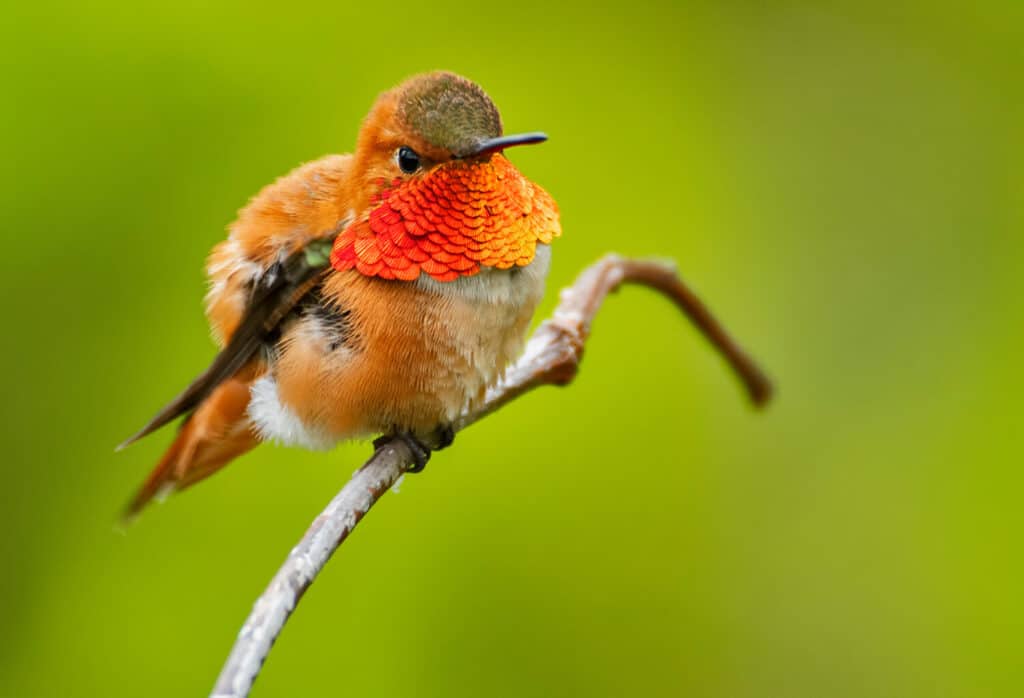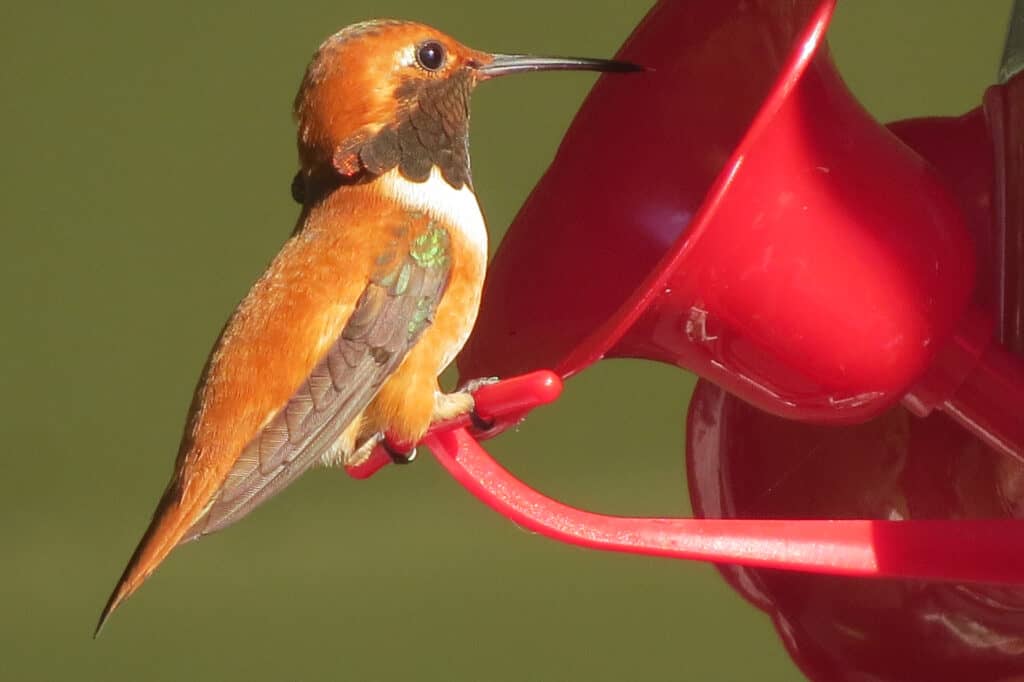As the vibrant hues of autumn paint the Nevada landscape, it signals the impending departure of the enchanting hummingbirds that grace gardens and parks throughout the summer. These tiny, iridescent creatures captivate our hearts with their delicate beauty and mesmerizing flight patterns. But when exactly do these remarkable birds bid adieu to the Silver State and embark on their incredible migratory journey? In this article, we delve into the fascinating world of hummingbirds and discover when they leave Nevada. We explore the factors that influence their migratory patterns and shed light on the destinations they seek during the colder months. Whether you’re an avid birdwatcher, a nature enthusiast, or simply curious about these remarkable birds, join us as we unravel the mysteries of when hummingbirds are set to flee Nevada.
When Do Hummingbirds Leave Nevada?

Annas hummingbirds are a common sight in Nevada.
©iStock.com/Jedlovec
Hummingbirds in Nevada begin leaving the state in early September. They migrate to their over-wintering areas during this time.
Signs to Look Out for
As hummingbirds set to leave Nevada, there are some common signs to look out for to determine when they are about to depart:
Seasonal Change
Hummingbirds typically leave Nevada in early September as the days grow shorter and the temperature starts to drop. This change in season signals the beginning of their migration.
Decreased Hummingbird Activity
As hummingbirds prepare for migration, you may notice a decrease in their activity around your garden or feeding stations. They may visit less frequently or for shorter periods of time.
Empty Feeders
If you have hummingbird feeders, you may notice that they are not being emptied as quickly or not being visited at all. This can be an indication that hummingbirds have started their journey south.
Lack of Nesting Activity
Hummingbirds typically build nests and raise their young during the summer months. If you no longer see any nesting activity in your area, it could be a sign that the hummingbirds have left.
Sighting Reports
Monitoring local birdwatching groups or websites can provide valuable information on hummingbird sightings in your area. If there are reports of fewer hummingbird sightings or sightings of migrating hummingbirds, it suggests that they are on their way out of Nevada.
It’s important to note that the timing of hummingbird departure can vary slightly depending on the specific species and environmental conditions. Keeping an eye out for these signs can give you a general idea of when hummingbirds are about to leave Nevada.
Hummingbird Species Migration in Nevada

Rufous hummingbirds are spotted in Nevada when they are migrating during the fall.
©punkbirdr/Shutterstock.com
Hummingbird migration in Nevada varies depending on the species. Here is some information about the migration of hummingbird species in Nevada:
Anna’s Hummingbird
Anna’s Hummingbirds are the only year-round residents in Nevada and the largest hummingbird species in the region. They do not migrate long distances like other hummingbird species and can be found in Nevada throughout the year.
Rufous Hummingbird
Rufous hummingbirds are considered a near-threatened species and are known to migrate through Nevada during their fall migration, mostly from July to September. They may pass through Nevada on their way to their wintering grounds in Mexico or Central America.
Black-Chinned Hummingbird
Black-chinned hummingbirds are a migrating species and are considered the hummingbirds of the West. They migrate north from Mexico and Central America each year, and Nevada is part of their migration route. They can be seen in Nevada during the summer months.
Calliope Hummingbird
Calliope Hummingbirds are one of the smallest bird species in North America. They breed in the western United States, including Nevada, and migrate to Mexico for the winter.
Broad-Tailed Hummingbird
Broad-tailed hummingbirds breed in the Western United States, including Nevada, and migrate to Mexico and Central America for the winter.
Costa’s Hummingbird
Costa’s hummingbirds are found in the Southwestern United States, including parts of Nevada. They are known for their distinctive buzzing sounds and short migratory habits.
Allen’s Hummingbird:
Allen’s hummingbirds breed along the Pacific coast and can be found in parts of Nevada during migration. They typically winter in Mexico.
Factors Influencing Hummingbird Migration Patterns in Nevada
Factors influencing hummingbird migration patterns in Nevada can vary and may include a combination of environmental, biological, and ecological factors. Here are some potential factors that could play a role:
Food Availability
Hummingbirds rely on nectar from flowers as their primary food source. The availability of nectar-rich flowers along their migration route can influence their timing and patterns of migration. Changes in flowering patterns due to seasonal variations or habitat changes can impact their migration.
Climate and Weather Patterns
Hummingbirds are sensitive to changes in temperature and weather conditions. They may time their migration based on favorable weather conditions, such as wind patterns and temperature. Climate change and extreme weather events could potentially affect their migration patterns.
Breeding and Nesting Behavior
Hummingbirds migrate to find suitable breeding and nesting areas. Factors such as the availability of suitable habitats, nesting sites, and competition for resources can influence their migration patterns. Changes in habitat due to human activities or natural disturbances can impact their breeding and nesting success.
Geographical Features
The geographical features of Nevada, such as mountains, valleys, and bodies of water, can influence the migratory routes of hummingbirds. They may follow specific flyways or utilize certain habitats along their journey.
Genetic Programming
Hummingbird migration is also influenced by genetic programming. Certain species have innate migratory behaviors and follow ancestral routes based on genetic cues.
Hummingbird Migration and the Impact on Nevada’s Ecosystem

Hummingbirds are pollinators of the state’s native flowers, making them valuable to the ecosystem.
©yhelfman/Shutterstock.com
Hummingbirds are vital to the ecology in Nevada and their migration can have several impacts on Nevada’s ecosystem. Here are some potential impacts:
Pollination
Hummingbirds are important pollinators for many flowering plants. During their migration, hummingbirds visit various flowers for nectar, inadvertently transferring pollen from one flower to another. This process facilitates plant reproduction and contributes to the diversity and health of Nevada’s plant ecosystems.
Seed Dispersal
Some hummingbird species play a role in seed dispersal. As they feed on nectar, they may consume small seeds or inadvertently carry them on their bodies. When hummingbirds move between different habitats during migration, they can help disperse seeds, contributing to plant dispersion and colonization.
Ecological Balance
Hummingbirds are part of the food web in Nevada’s ecosystems. They serve as a food source for predators such as birds of prey and snakes. Their presence and migration can help maintain the ecological balance by providing a food resource for other species.
Economic Value
Hummingbirds can also have economic value through ecotourism. Birdwatchers and nature enthusiasts may visit Nevada to observe and photograph hummingbirds during their migration. This can contribute to local economies through tourism and associated businesses.
Where Do Hummingbirds Go When They Leave Nevada?
When hummingbirds leave Nevada during migration, their destinations can vary depending on the species. Here are some general patterns and destinations for hummingbirds leaving Nevada:
Northward Migration
Some hummingbird species, such as the rufous hummingbird, undertake long-distance migrations and can travel as far north as Alaska. They rely on nectar plants and suitable habitat throughout Nevada and other states to fuel their journey. They may continue their migration to breeding grounds in western Canada and Alaska.
Westward Migration
Some hummingbirds that migrate from Nevada may head west towards the Pacific Coast. They may stop in coastal areas of California and other western states, where they can find suitable habitats and food sources.
Southward Migration
Some hummingbird species may migrate southward from Nevada to wintering grounds in Mexico, Central America, or even as far as South America. These birds rely on nectar-rich habitats along their migration route to sustain themselves during the journey and throughout the winter months.
When Do Hummingbirds Return to Nevada?
Hummingbirds return to Nevada at different times depending on the species. Here are some general patterns of hummingbird arrival in Nevada:
Anna’s Hummingbird
Anna’s hummingbirds are year-round residents in Nevada. They may move down to the foothills for nesting from December to June.
Black-Chinned Hummingbird
Black-chinned hummingbirds breed in Nevada during the summer months. They typically start arriving in April.
Rufous Hummingbird
Rufous hummingbirds are known to migrate as far north as Alaska in the summer. They rely on habitat and nectar plants throughout Nevada and Utah to fuel their journey. They are spotted in Nevada during migration, mostly in the fall from July to November.
Other Migrating Hummingbirds
Nevada may also see other migrating hummingbird species, such as Costa’s Hummingbird and several other species, which begin arriving in Nevada as early as the beginning of March and continue north to their breeding grounds.
It’s important to note that the specific arrival times of hummingbirds in Nevada can vary depending on factors such as weather conditions and the availability of suitable habitats and food sources.
How To Help Hummingbirds When They Return to Nevada

When eating at a hummingbird feeder, rufous hummingbirds like to perch.
©Rachel Lambert/Shutterstock.com
When hummingbirds return to Nevada, there are several ways you can help create a welcoming environment for them. Here are some ways to help hummingbirds when they return to Nevada:
Provide a Reliable Food Source
Plant native flowers and flowering plants that produce nectar, such as penstemons, salvias, and columbines. These plants will provide a natural food source for hummingbirds. You can also hang hummingbird feeders filled with a sugar-water solution (1 part sugar to 4 parts water, no red dye) to supplement their nectar intake.
Create a Habitat
Create a hummingbird-friendly habitat by planting trees, shrubs, and vines that provide shelter and nesting sites for hummingbirds. Dense vegetation can also provide protection from predators.
Avoid Pesticides
Minimize or eliminate the use of pesticides in your garden, as they can be harmful to hummingbirds and other pollinators. Opt for organic pest control methods or natural alternatives to protect your plants.
Provide Water Sources
Hummingbirds need water for drinking and bathing. Provide them with shallow water sources, such as birdbaths or shallow dishes with stones for perching.
Maintain Feeders and Plants
Keep hummingbird feeders clean and filled with fresh nectar. Regularly prune and maintain flowering plants to ensure a continuous supply of nectar throughout the hummingbirds’ stay.
Create a Hummingbird-Friendly Environment
Place feeders and plants in areas that are easily visible and accessible to hummingbirds. Consider adding perches or small branches near the feeders and plants to provide resting spots for the birds.
The photo featured at the top of this post is © Birdiegal/Shutterstock.com
Thank you for reading! Have some feedback for us? Contact the AZ Animals editorial team.







